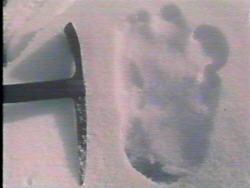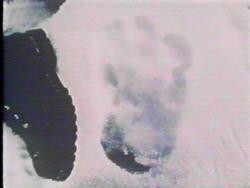
Greetings earthlings, or whatever. Sorry about the delay in getting this blog completed, but this narcolepsy thing has slowed my work rate down considerably. Still, I've been feeling pretty good this morning and decided to get cracking.
In August 2001 I penned an article for
Animals & Men about a mystery big cat sighting in Cleadon Village, which is only a couple of miles from where I live. The case caused an absolute sensation in the local press but for some reason was never to my knowledge picked up by specialist magazines dealing with cryptozoology and other weird stuff – except for
Animals & Men, that is. To be honest, given the frequency of the sightings and the multiplicity of witnesses, the fact that no one outside of the Borough of South Tyneside seemed even remotely interested in the Cleadon Big Cat baffled me even more than the critter itself did.
The Cleadon Big Cat was first spotted on January 11th 1999 and continued to make unscheduled appearances for several weeks. I wrote the entire story up in my book
Mystery Animals of the British Isles: Northumberland & Tyneside (CFZ Press, 2008) and actively sought out the creature on a number of occasions. Eventually, like most out-of-place cryptids, it simply disappeared and has never reappeared since. And there the story ended, or so I thought. However, over a decade after the Cleadon Big Cat first strutted onto the cryptozoological stage, something has happened to resurrect it. Or maybe not, as it's all a bit confusing.
Several days ago I visited the Marsden Grotto pub in nearby South Shields – which I've also written extensively about (
The House That Jack Built, Amberley Publishing, 2008) – and was accompanied by several researchers from Northumberland. Two of them happened to be John and Kelly Triplow, who have singularly impressed me by their professional approach to preternatural research. John told me about a website that contained an intriguing BHM story, not unlike that of the infamous Beast of Bolam Lake, which I actively investigated with a CFZ team in early 2003. What puzzled John – and it certainly puzzled me – was that this BHM sighting allegedly occurred in Cleadon Village in that very same year.
Let me explain why I was so baffled. The Borough of South Tyneside is the smallest Metropolitan Borough in the UK. It consists of six towns and villages, a few farms and…well that's about it actually. It also happens to be one of the hottest spots around for paranormal research, and I've written a good few books, articles and columns dealing with the wacky stuff that seems to happen here more than anywhere else I know. South Tyneside is Spook Central, the Grand Central Station of UFOs and the King's Cross of Weirdness. But it is incredibly small nonetheless, and nothing – and I mean nothing – of paranormal provenance escapes my notice if it occurs within this petite but perfectly formed landscape of Geordie culture. How, then, did the presence of a BHM almost literally on my own doorstep slip past me?
The website drawn to my attention by John is
http://www.blogger.com/www.ufoinfo.com and the BHM report in question was posted there on
http://www.blogger.com/www.ufoinfo.com/humanoid/humanoid2003.shtmlAccording to the website, the unnamed witness stumbled upon a large, bipedal animal. As the sighting occurred at night-time it was impossible for the witness to give a detailed description of the creature, although they did believe that it was covered in thick fur.
The witness was apparently 50 yards or so away from the creature, which they spotted walking adjacent to a nearby line of trees. When the creature saw the witness it became startled and ran into the trees and disappeared. The only other detail in the account was that the first witness saw a second person in the vicinity who was apparently walking a dog.
Firstly, it needs to be pointed out that there is nothing in this report that is inconsistent with the topography of Cleadon Village. There are numerous fields lined with trees that could tentatively serve as the true location of the sighting. However, it seemed more than a little odd to me that this BHM sighting should occur in the same village that had only a short while previously been the setting for the infamous Cleadon Big Cat incident. Two spectacular cryptids in the one village, only a few short years apart? It also seemed odd that the Cleadon BHM should have made its first appearance only months after the Bolam Lake story broke the news. Both stories had a common denominator, and it was I. I'd written both accounts up in my WraithScape column in The Shields Gazette. Further, I'd actively investigated both encounters and lived only a hop, skip and jump away from Cleadon. Was it possible that the two stories had somehow become confused?
My suspicions were further fuelled by the presence of someone walking a dog when the Cleadon BHM was allegedly seen. During my investigation into the Cleadon Big Cat case, the press (The Shields Gazette, January 14, 1999) reported that a woman who had been walking her huge Burmese mountain dog on Cleadon Hills believed that she – or rather her pet – may have been mistaken for the big cat. I was subsequently able to discount this, but the fact that both the Cleadon Big Cat story and the account of the Cleadon BHM included a dog-walker on Cleadon Hills at the time of each sighting again made me wonder if the two stories had been melded together.
And there was another similarity. One of the witnesses in the Cleadon Big Cat case claimed that he'd seen the animal running past his hedge, approximately fifty feet away. If one substitutes the words 'tree line' for 'hedge' and 'fifty yards' for 'fifty feet', the two accounts are unnervingly similar. Nevertheless, if there was even the remotest possibility that the two accounts were different and that the BHM report was essentially genuine, then I knew I'd have to look into it further. I promptly penned an e-mail to the UFOINFO site and asked them if they could provide me with the source of the original story. I haven't had a reply as yet, but as soon as I do I'll keep CFZ acolytes informed.
Until I heard from UFOINFO, I decided to work on the presumption that the story was genuine and investigate it anyway. My first task was to track down any potential witnesses, and so I decided to write up the story in my WraithScape column. The Shields Gazette is one of two provincial papers sold in Cleadon Village, and I knew that if there were any people out there who had witnessed a huge biped stomping around the vicinity then I'd sharp find out about it. My column is due to appear on Thursday 17th December, and if I get a positive result you'll be the first to know.
Meanwhile, if anyone reading this blog knows about this story or has read it elsewhere, please get in touch. Anyway, I must dash – I've a bus to catch to Cleadon Village where a hot date with a hirsute biped awaits me….
 When one thinks of cryptids in New Jersey, most people go no further than the Jersey Devil, which is so ubiquitous that it even lent its name to an unofficial record by the State's most lucrative cultural export - Bruce Springsteen.
When one thinks of cryptids in New Jersey, most people go no further than the Jersey Devil, which is so ubiquitous that it even lent its name to an unofficial record by the State's most lucrative cultural export - Bruce Springsteen.









 None of these tracks resembled the imprint in snow of the local brown bears - bear tracks show claws and the yeti does not. Shipton's photograph show no claws.
None of these tracks resembled the imprint in snow of the local brown bears - bear tracks show claws and the yeti does not. Shipton's photograph show no claws.








